Sam, Colin and I were talking about biodiesel last night as walk-home talk fodder. It's a great thing--a no-modification substitute for fossil fuel diesel. Every gallon of biodiesel does nothing for carbon or pollution emissions or energy use, but reduces our dependance on Middle-East oil by a gallon. Naysayers complain about its sluggishness in cold weather, but this is standard behavior for #2 diesel, and complaints from Minnesota about it are related to poor-quality vendor biodiesel. Get companies that care about (or are forced to) producing a quality product and the clogs will stop.
The New York Times is reporting that President Bush will be talking about national energy policy in tonight's State of the Union. As usual, instead of dealing with proven strategies for increasing efficiency, he will argue for more pie-in-the-sky ideas that are far off. Far off enough to dump large subsidies into corporations for research of bad ideas, like the hydrogen car. Remember the hydrogen car? Instead of increasing today's automobiles' gas mileage by a few MPG by raising the CAFE requirements and getting the huge exemption of SUVs into the fold, he dropped them and asked for research into a non-proven, non-existent technology. Drop the idea of fuel-cells for cars. Stick them in houses, where they would actually work great.
It's a standard technique--drop funding for some project that could work but isn't on their party's agenda (cough hybrids cough). Claim that you have to use that money to research for something in the future like the hydrogen car. Watch as corporations use that R&D money to do nothing important. Quietly drop funding a few years later, claiming hydrogen cars weren't feasible. Congratulations! You've killed funding for the thing the other party wanted, without people noticing. Sound familiar, NASA? Drop science funding for "Manned space exploration of the Moon". Quietly kill that in a few years. Science funding never comes back.
The government should do three things for the energy security of the United States.
1. Spend on Research and Development, and avoid throwing money at corporate welfare. Science is very important for the long-term future, and its funding should never be in jeopardy.
2. There is nothing inherently wrong in nuclear power--it's cleaner than coal (yes, a point for another post). We need new energy sources as use naturally increases with time, and it's the most efficient way.
3. Reprocess nuclear fuel and recover the huge amounts of wasted U-235 and Plutonium that are just left to rot. Reprocessing would drop the need to immediately build Yucca Mountains every twenty years.
4. Encourage inexpensive solar energy development. Why haven't we powered Las Vegas, Los Angeles, San Diego, or Phoenix via solar power yet? Just using simple solar water heaters is a cheap and great start. My family heated our water for years with solar--why can't everyone in the southwest do this?
5. Biodiesel is a great option to immediately encourage--a direct replacement for diesel, especially in warm climates. Subtracting the national cost of supporting Middle-East oil, it becomes cheaper than you think.
6. Increase the efficiency of cars, and continue tax credits for all hybrids, including popular ones, but don't let the manufacturers trade efficiency for power.
Tuesday, January 31, 2006
Friday, January 27, 2006
Saturn
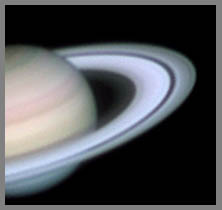
Saturn reaches opposition today. Last night was a beautifully clear and warmish Ryerson Thursday observing night. The seeing was perfect too, leaving us agog with fantastic views of Saturn and its moons. It's a little tough identifying the satellites versus the field stars since Saturn is gliding on the edge of the Beehive open cluster, but we saw Titan, Dione, Rhea, and Tethys. My ID of Titan was from its brightness (i.e., not the brightest field star, but around magnitude 8), and the last three by their similarity and close positions to Saturn.
Need to identify Saturn's moons? Use Sky and Telescope's useful javascript tool: Saturn's Moons Javascript applet. They also have an observing guide to Saturn.
Alan Friedman has a nice image taken a few days ago that shows essentially what we saw last night, although we didn't see the Encke Gap.
Thursday, January 26, 2006
Snow tracks
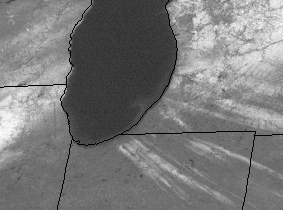
Today's visible NOAA satellite image of the Chicago region showed the remnants of two snow bearing systems, one a big snow system on Friday night, which moved from the SW to NE, the other a set of lake effect snows extending southeast from Lake Michigan into Indiana. The lake effect can be seen here.
The image is courtesy of the University of Wisconsin's Space Science and Engineering Center, which provides great images for those of us near Madison.
Wednesday, January 25, 2006
Groom Lake aka Area 51 aka The Ranch
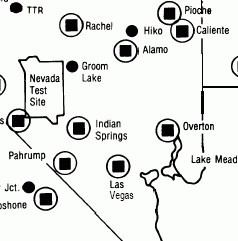
Be amused that a 1989 report on the containment of radiation from underground nuclear tests from the Office of Technology Assessment, a moribund Congressional office, casually mentioned that there was a monitoring station for accidental radioactive releases from the Nevada Test Site at a classified non-existent location. They also mention the sensitive Tonopah Test Range on the map. Those wacky Congressional Reports!
The Containment of Underground Nuclear Explosions (PDF)
It's on page 69.
You can visit any of the community monitoring stations, and I recommend it if you are ever in any of the towns. In Las Vegas it's located in the parking lot of the Atomic Testing Museum, at Flamingo and Swenson.
Sunday, January 15, 2006
Comet Wild 2 and Stardust
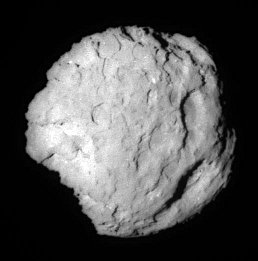
Phil Plait's Bad Astronomy has a good post about the source of Stardust's material: http://www.badastronomy.com/bablog/2006/01/14/the-return-of-stardust/
P.S. I should note the parent spacecraft has to alter its orbit to avoid the Earth and continue on its extended mission.
Monday, January 09, 2006
Stardust return
Stardust will return comet dust samples to Earth Saturday night. I was amused by this statement in an Associated Press article:
My first thought was "Residents? Along I-80?"
Tongue-in-cheek, of course.
Residents in parts of Northern California, Oregon, Washington, Idaho, Nevada and Utah should see the Stardust capsule as it streaks across the pre-dawn sky. Prime viewing will be along Nevada's Interstate 80 where residents can view the capsule's front.
My first thought was "Residents? Along I-80?"
Tongue-in-cheek, of course.
Concerning two Nebulae in the Pleiades (Barnard's and the Merope)
After seeing today's APOD, I've decided to force myself to finish this long-overdue post.

(Here's a photo of the Pleiades taken in the 1950's from Ryerson through a Schmidt camera. Merope is at the top).
While at Lick Observatory, E.E. Barnard noticed a small bright nebula right next to the very bright star Merope in the Pleiades. The existence of the faint bluish nebula surrounding Merope had been discovered by Wilhelm Tempel in 1859, although argued about until photography proved its existence. Barnard though found a bright, tiny nebula extremely close to Merope on the evening of November 14th, 1890. He writes in Astronomische Nachrichten, volume 126, p.293:
In later papers like Astronomische Nachrichten, volume 127, p.135 he reports it seems significantly different from the wispy reflection nebulae that surround Merope and the other Pleiades and that it hadn't been photographed before merely because it was so close to the blindingly bright Merope.
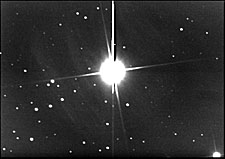
I caught some of the wispy Merope Nebula with a non-blue sensitive CCD camera from Chicago a while ago.
Since reflection nebulas are made of small dust particles, smaller than a wavelength of light, they scatter smaller wavelength light much more effectively than longer wavelengths and turn quite blue (like tobacco smoke seen from the side). When you see blue smoke coming from car's exhaust (and that oil is burning in the engine), you can make a smart guess that the particulates are under 700nm in size. If they were any bigger, they would look white.
Some confusion has occurred in discussing this nebula. The small bright nebula is "Barnard's Merope Nebula" or IC 349. The diffuse nebula surrounding Merope is called "Merope Nebula" which is NGC 1435.
Johannes Schedler's Merope close-up is a fantastic capture of both the nebula, bright Merope, and the faint wispy Pleiades nebula.
Roland Christen's close-up
Herbig later describes the nebula is great detail: Herbig: IC 349: Barnard's Merope Nebula and details how it's not the same dust that makes up the wispy Pleiades nebula, but something different, something with a separate velocity through space.
Later, he has Hubble look at it: http://imgsrc.hubblesite.org/hu/db/2000/36/images/a/formats/web_print.jpg
Barentine and Esquerdo also talk about it here: http://www.journals.uchicago.edu/AJ/journal/issues/v117n3/980312/980312.html (may require subscription).

(Here's a photo of the Pleiades taken in the 1950's from Ryerson through a Schmidt camera. Merope is at the top).
While at Lick Observatory, E.E. Barnard noticed a small bright nebula right next to the very bright star Merope in the Pleiades. The existence of the faint bluish nebula surrounding Merope had been discovered by Wilhelm Tempel in 1859, although argued about until photography proved its existence. Barnard though found a bright, tiny nebula extremely close to Merope on the evening of November 14th, 1890. He writes in Astronomische Nachrichten, volume 126, p.293:
On Nov. 14 while examing the cluster, I discovered a new and comparatively bright round cometary nebula close south and following Merope, every precaution was taken to prove that it was not a ghost of Merope by examing the other stars of the group under the same conditions. I have since seen it several times and on Dec. 8th I could see it with some difficulty in the 12 inch by occulting Merope with a wire in the eyepiece. With the great telescope the nebula can be seen fairly well with Merope in the field and is conspicuous when the star is placed just outside the north edge of the field. It is about 30" in diameter, of the 13m , gradually brighter in the middle and very cometary in appearance. It was examined with powers of 300, 520 and 1500 with all of which it was comparatively easy.
In later papers like Astronomische Nachrichten, volume 127, p.135 he reports it seems significantly different from the wispy reflection nebulae that surround Merope and the other Pleiades and that it hadn't been photographed before merely because it was so close to the blindingly bright Merope.

I caught some of the wispy Merope Nebula with a non-blue sensitive CCD camera from Chicago a while ago.
Since reflection nebulas are made of small dust particles, smaller than a wavelength of light, they scatter smaller wavelength light much more effectively than longer wavelengths and turn quite blue (like tobacco smoke seen from the side). When you see blue smoke coming from car's exhaust (and that oil is burning in the engine), you can make a smart guess that the particulates are under 700nm in size. If they were any bigger, they would look white.
Some confusion has occurred in discussing this nebula. The small bright nebula is "Barnard's Merope Nebula" or IC 349. The diffuse nebula surrounding Merope is called "Merope Nebula" which is NGC 1435.
Johannes Schedler's Merope close-up is a fantastic capture of both the nebula, bright Merope, and the faint wispy Pleiades nebula.
Roland Christen's close-up
Herbig later describes the nebula is great detail: Herbig: IC 349: Barnard's Merope Nebula and details how it's not the same dust that makes up the wispy Pleiades nebula, but something different, something with a separate velocity through space.
Later, he has Hubble look at it: http://imgsrc.hubblesite.org/hu/db/2000/36/images/a/formats/web_print.jpg
Barentine and Esquerdo also talk about it here: http://www.journals.uchicago.edu/AJ/journal/issues/v117n3/980312/980312.html (may require subscription).
Wednesday, January 04, 2006
New Horizons--aka the Pluto and Kuiper Belt mission
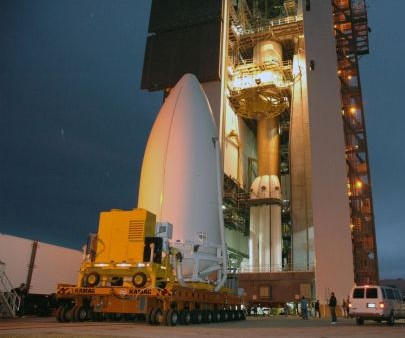
The New Horizons spacecraft is nearing a possible launch in mid-January. Despite the moniker its mission is to explore the Pluto/Charon system and any Kuiper Belt objects beyond. We know from looking at their spectrums that Pluto and Charon are different--Pluto is covered in nitrogen ice (brrr) and Charon has water ice. Pluto itself has significant albedo differences, including presumably brighter icier poles and darker warmer equatorial regions (although mixed in everywhere are bright and dark areas--are they cryovolcanoes and geysers or just cratering?). Young, Galdamez, Buie, Binzel, and Tholen used a series of mutual occultations of Pluto and Charon to figure this out in this paper (Link may require a subscription to read).
The Official New Horizons web site
Was this a wasteful governmental project? Nope. It cost less than 1/10 (one-tenth) of a single B-2, or about the same as the Ketchikan, Alaska bridge to nowhere. For the same price we get the first close-up views of the Kuiper Belt.
I have an older animated image I took of Pluto taken from Ryerson here. It shows Pluto appearing to move over an hour and a half, near the center left of the image.
Via http://planetary.org/blog/article/00000334/.
Subscribe to:
Posts (Atom)